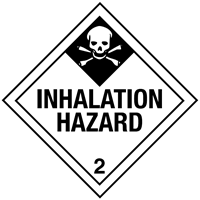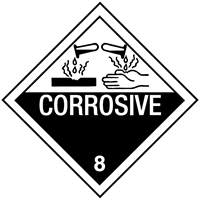
 Print
Print
Chemical Datasheet
SULFUR DIOXIDE |


|
Chemical Identifiers
| CAS Number |
UN/NA Number |
DOT Hazard Label |
USCG CHRIS Code |
- 7446-09-5

|
|
|
|
| NIOSH Pocket Guide |
International Chem Safety Card |
|
Sulfur dioxide
|
|
NFPA 704
General Description
A colorless gas with a choking or suffocating odor. Boiling point -10°C. Heavier than air. Very toxic by inhalation and may irritate the eyes and mucous membranes. Under prolonged exposure to fire or heat the containers may rupture violently and rocket. Used to manufacture chemicals, in paper pulping, in metal and food processing.
Rate of onset: Immediate & Delayed
Persistence: Minutes to hours
Odor threshold: 1 ppm
Source/use/other hazard: Disinfectant and preserving in breweries and food/canning; textile industry; batteries.
Hazards
Reactivity Alerts
Air & Water Reactions
Dissolves in water to form sulfurous acid, a corrosive liquid. Moist sulfur dioxide is very corrosive due to the slow formation of sulfuric acid [Handling Chemicals Safely 1980 p. 876].
Fire Hazard
Containers may explode in heat of fire or they may rupture and release irritating toxic sulfur dioxide. Sulfur dioxide has explosive properties when it comes in contact with sodium hydride; potassium chlorate at elevated temperatures; ethanol; ether; zinc ethylsulfurinate at very cool temperatures (-15C); fluorine; chlorine trifluoride and chlorates. It will react with water or steam to produce toxic and corrosive fumes. When the liquid is heated it may release irritating, toxic sulfur dioxide gas. Avoid ammonia, monocesium or monopotassium acetylide; dicesium monoxide; iron (II) oxide; tin oxide; lead (IV) oxide; chromium; manganese; molten sodium, powder aluminum and rubidium. Sulfur dioxide has explosive properties when it comes in contact with sodium hydride; potassium chlorate at elevated temperatures; ethanol; ether; zinc ethylsulfurinate at very cool temperatures (-15C); fluorine; chlorine trifluoride and chlorates. It will react with water or steam to produce toxic and corrosive fumes. Hazardous polymerization may not occur. (EPA, 1998)
Health Hazard
It may cause death or permanent injury after very short exposure to small quantities. 1,000 ppm causes death in from 10 minutes to several hours by respiratory depression. It is an eye and respiratory tract irritant. Persons with asthma, subnormal pulmonary functions or cardiovascular disease are at a greater risk. (EPA, 1998)
Reactivity Profile
SULFUR DIOXIDE is acidic. Reacts exothermically with bases such as amines, amides, metal oxides, and hydroxides. Frequently used as a reducing agent although it is not a powerful one. Acts as a reducing bleach to decolorize many materials. Can act as an oxidizing agent. Supports combustion of powdered aluminum [Mellor 5:209-212 1946-47]. Reacts explosively with fluorine [Mellor 2:1 1946-47]. Supports burning of manganese [Mellor 12:187 1946-47]. Readily liquefied by compression. Contact between the liquid and water may result in vigorous or violent boiling and extremely rapid vaporization. If the water is hot an explosion may occur. Pressures may build to dangerous levels if the liquid contacts water in a closed container [Handling Chemicals Safely 1980]. Supports incandescent combustion of monocesium acetylide, monopotassium acetylide, cesium oxide, iron(II) oxide, tin oxide, and lead oxide [Mellor]. Ethylene oxide and SO2 can react violently in pyridine solution with pressurization if ethylene oxide is in excess (Nolan, 1983, Case History 51).
Belongs to the Following Reactive Group(s)
- Acids, Strong Non-oxidizing
- Reducing Agents, Weak
Potentially Incompatible Absorbents
No information available.
Response Recommendations
Isolation and Evacuation
Excerpt from ERG Guide 125 [Gases - Toxic and/or Corrosive]:
IMMEDIATE PRECAUTIONARY MEASURE: Isolate spill or leak area for at least 100 meters (330 feet) in all directions.
SPILL: See ERG Tables 1 and 3 - Initial Isolation and Protective Action Distances on the UN/NA 1079 datasheet.
FIRE: If tank, rail tank car or highway tank is involved in a fire, ISOLATE for 1600 meters (1 mile) in all directions; also, consider initial evacuation for 1600 meters (1 mile) in all directions. (ERG, 2024)
Firefighting
Wear self-contained breathing apparatus and full protective clothing. Move container from fire area. Stay away from ends of tanks. Cool containers that are exposed to flames with water from the side until well after the fire is out. Isolate area until gas has dispersed. Keep unnecessary people away.
Not flammable. Extinguish fires with dry chemical, carbon dioxide, water spray, fog or foam. (EPA, 1998)
Non-Fire Response
Excerpt from ERG Guide 125 [Gases - Toxic and/or Corrosive]:
Do not touch or walk through spilled material. Stop leak if you can do it without risk. If possible, turn leaking containers so that gas escapes rather than liquid. Prevent entry into waterways, sewers, basements or confined areas. Do not direct water at spill or source of leak. Use water spray to reduce vapors or divert vapor cloud drift. Avoid allowing water runoff to contact spilled material. Isolate area until gas has dispersed. (ERG, 2024)
Protective Clothing
Excerpt from NIOSH Pocket Guide for Sulfur dioxide:
Skin: FROSTBITE - Compressed gases may create low temperatures when they expand rapidly. Leaks and uses that allow rapid expansion may cause a frostbite hazard. Wear appropriate personal protective clothing to prevent the skin from becoming frozen.
Eyes: FROSTBITE - Wear appropriate eye protection to prevent eye contact with the liquid that could result in burns or tissue damage from frostbite.
Wash skin: No recommendation is made specifying the need for washing the substance from the skin (either immediately or at the end of the work shift).
Remove: WHEN WET OR CONTAMINATED (LIQUID) - If this chemical is in liquid form, work clothing that becomes wet or significantly contaminated should be removed and replaced.
Change: No recommendation is made specifying the need for the worker to change clothing after the workshift.
Provide: FROSTBITE WASH - Quick drench facilities and/or eyewash fountains should be provided within the immediate work area for emergency use where there is any possibility of exposure to liquids that are extremely cold or rapidly evaporating. (NIOSH, 2024)
DuPont Tychem® Suit Fabrics
Normalized Breakthrough Times (in Minutes)
| Chemical |
CAS Number |
State |
QS |
QC |
SL |
C3 |
TF |
TP |
RC |
TK |
RF |
| Sulfur dioxide |
7446-09-5 |
Vapor |
|
imm |
>480 |
|
28*/46 |
26*/37 |
>480 |
>480 |
>480 |
Special Warning from DuPont: Tychem® and Tyvek® fabrics should not be
used around heat, flames, sparks or in potentially flammable or
explosive environments. Only...
(DuPont, 2024)
First Aid
Note: Persons with asthma, subnormal pulmonary function, or cardiovascular disease are at greater risk.
Signs and Symptoms of Acute Sulfur Dioxide Exposure: Sulfur dioxide may irritate the eyes and respiratory tract. Signs and symptoms of acute exposure to sulfur dioxide may be severe and include coughing, choking, dyspnea (shortness of breath), sneezing, wheezing, and chest discomfort. Upper airway edema (swelling) or obstruction, bronchoconstriction, pneumonia, pulmonary edema, and respiratory paralysis may occur. Fatigue may be noted. Gastrointestinal effects may include nausea, vomiting, and abdominal pain. Cyanosis (blue tint to skin and mucous membranes) may be noted following exposure to sulfur dioxide.
Emergency Life-Support Procedures: Acute exposure to sulfur dioxide may require decontamination and life support for the victims. Emergency personnel should wear protective clothing appropriate to the type and degree of contamination. Air-purifying or supplied-air respiratory equipment should also be worn, as necessary. Rescue vehicles should carry supplies such as plastic sheeting and disposable plastic bags to assist in preventing spread of contamination.
Inhalation Exposure:
1. Move victims to fresh air. Emergency personnel should avoid self-exposure to sulfur dioxide.
2. Evaluate vital signs including pulse and respiratory rate, and note any trauma. If no pulse is detected, provide CPR. If not breathing, provide artificial respiration. If breathing is labored, administer oxygen or other respiratory support.
3. Obtain authorization and/or further instructions from the local hospital for administration of an antidote or performance of other invasive procedures.
4. Transport to a health care facility.
Dermal/Eye Exposure:
1. Remove victims from exposure. Emergency personnel should avoid self- exposure to sulfur dioxide.
2. Evaluate vital signs including pulse and respiratory rate, and note any trauma. If no pulse is detected, provide CPR. If not breathing, provide artificial respiration. If breathing is labored, administer oxygen or other respiratory support.
3. Remove contaminated clothing as soon as possible.
4. If eye exposure has occurred, eyes must be flushed with lukewarm water for at least 15 minutes.
5. Wash exposed skin areas with soap and water.
6. Obtain authorization and/or further instructions from the local hospital for administration of an antidote or performance of other invasive procedures.
7. Transport to a health care facility.
Ingestion Exposure: No information is available. (EPA, 1998)
Physical Properties
Flash Point: data unavailable
Lower Explosive Limit (LEL): data unavailable
Upper Explosive Limit (UEL): data unavailable
Autoignition Temperature:
Not flammable
(USCG, 1999)
Melting Point:
-98.9°F
(EPA, 1998)
Vapor Pressure:
2432 mmHg
at 68°F
(EPA, 1998)
Vapor Density (Relative to Air):
2.26
(EPA, 1998)
- Heavier than air; will sink
Specific Gravity:
1.434
(EPA, 1998)
- Denser than water; will sink
Boiling Point:
14°F
at 760 mmHg
(EPA, 1998)
Molecular Weight:
64.07
(EPA, 1998)
Water Solubility:
10 %
(NIOSH, 2024)
Ionization Energy/Potential:
12.30 eV
(NIOSH, 2024)
IDLH:
100 ppm
(NIOSH, 2024)
AEGLs (Acute Exposure Guideline Levels)
Final AEGLs for Sulfur Dioxide (7446-09-5)
| Exposure Period |
AEGL-1 |
AEGL-2 |
AEGL-3 |
| 10 minutes |
0.2 ppm |
0.75 ppm |
30 ppm |
| 30 minutes |
0.2 ppm |
0.75 ppm |
30 ppm |
| 60 minutes |
0.2 ppm |
0.75 ppm |
30 ppm |
| 4 hours |
0.2 ppm |
0.75 ppm |
19 ppm |
| 8 hours |
0.2 ppm |
0.75 ppm |
9.6 ppm |
(NAC/NRC, 2024)
ERPGs (Emergency Response Planning Guidelines)
| Chemical |
ERPG-1 |
ERPG-2 |
ERPG-3 |
| Sulfur Dioxide (7446-09-5)
|
0.3 ppm  |
3 ppm |
25 ppm |
(AIHA, 2022)
PACs (Protective Action Criteria)
| Chemical |
PAC-1 |
PAC-2 |
PAC-3 |
| Sulfur dioxide (7446-09-5)
|
0.2 ppm |
0.75 ppm |
30 ppm |
(DOE, 2024)
Regulatory Information
EPA Consolidated List of Lists
| Regulatory Name |
CAS Number/
313 Category Code |
EPCRA 302
EHS TPQ |
EPCRA 304
EHS RQ |
CERCLA RQ |
EPCRA 313
TRI |
RCRA
Code |
CAA 112(r)
RMP TQ |
| Sulfur dioxide |
7446-09-5 |
500 pounds |
500 pounds |
|
|
|
|
| Sulfur dioxide (anhydrous) |
7446-09-5 |
500 pounds |
500 pounds |
|
|
|
5000 pounds |
(EPA List of Lists, 2024)
CISA Chemical Facility Anti-Terrorism Standards (CFATS)
|
RELEASE |
THEFT |
SABOTAGE |
| Chemical of Interest |
CAS Number |
Min Conc |
STQ |
Security
Issue |
Min Conc |
STQ |
Security
Issue |
Min Conc |
STQ |
Security
Issue |
| Sulfur dioxide (anhydrous) |
7446-09-5 |
1.00 % |
5000 pounds |
toxic |
84.00 % |
500 pounds |
WME |
|
|
|
(CISA, 2007)
OSHA Process Safety Management (PSM) Standard List
| Chemical Name |
CAS Number |
Threshold Quantity (TQ) |
| Sulfur Dioxide (liquid) |
7446-09-5 |
1000 pounds |
(OSHA, 2019)
Alternate Chemical Names
- FERMENTICIDE LIQUID
- SULFUR DIOXIDE
- SULFUR DIOXIDE (ANHYDROUS)
- SULFUR DIOXIDE (SO2)
- SULFUR DIOXIDE, LIQUEFIED
- SULFUR OXIDE
- SULFUR OXIDE (SO2)
- SULFUR SUPEROXIDE
- SULFUROUS ACID ANHYDRIDE
- SULFUROUS ANHYDRIDE
- SULFUROUS OXIDE
- SULPHUR DIOXIDE
- SULPHUR DIOXIDE, LIQUEFIED



 Print
Print

